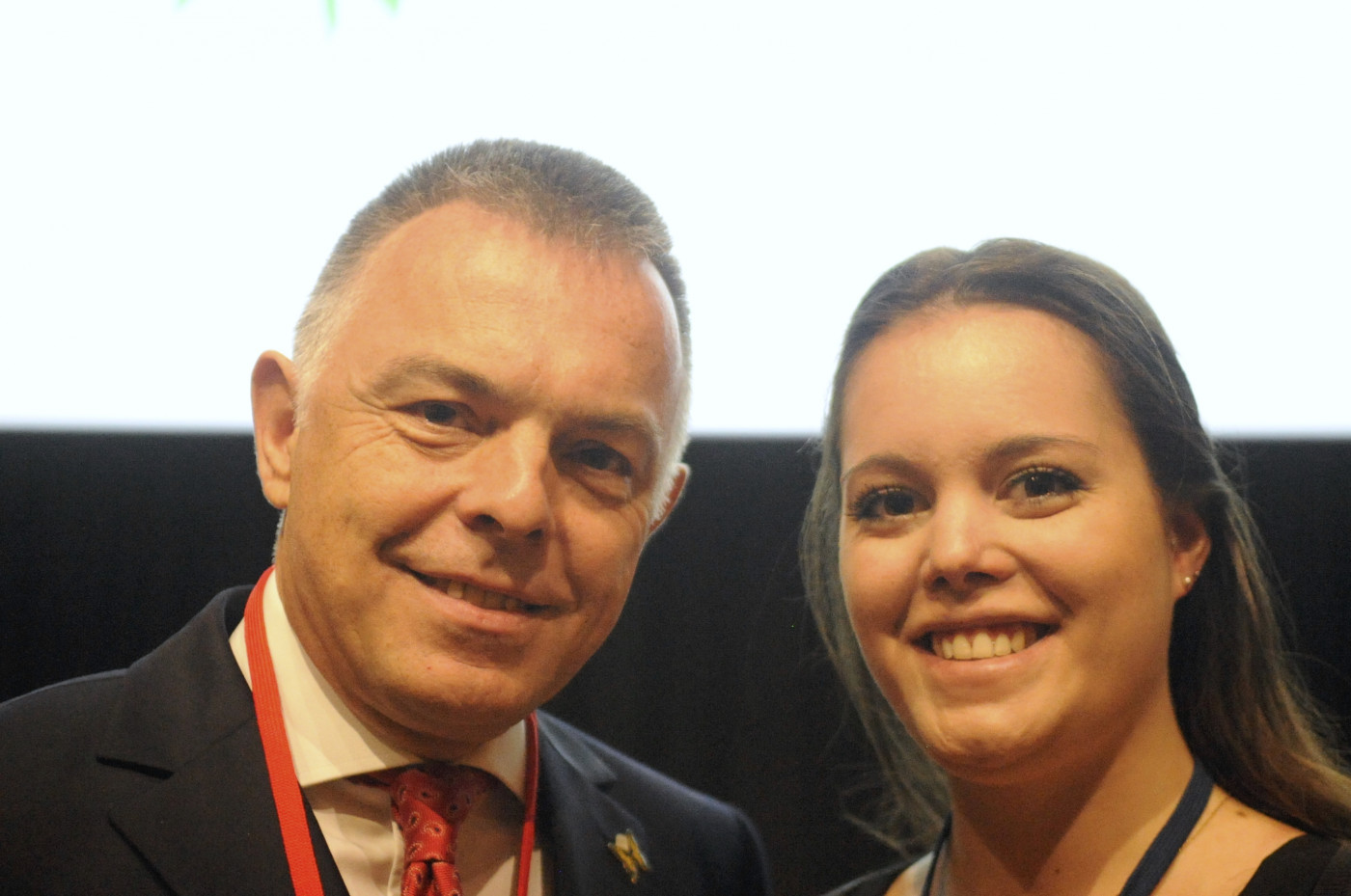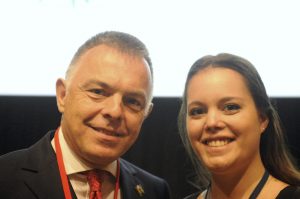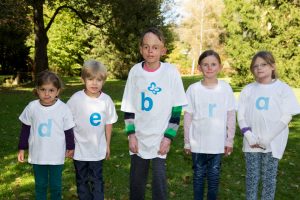Austrian Epidermolysis Bullosa Patient Inspires Dad to Establish World’s First ‘EB House’

Rainer Riedl, president of Pro Rare Austria, and his daughter, EB patient Lena Riedl. (Photo by Larry Luxner)
Lena Riedl, 24, has had epidermolysis bullosa (EB) since birth. Despite the suffering, she’s managed to turn her genetic “butterfly disease” into a career while inspiring her father, Rainer Riedl, to launch the world’s first dedicated EB clinic in her native Austria.
The cheerful young woman is a communications and marketing assistant at Asociación Piel de Mariposa, an EB nonprofit group headquartered in Marbella, Spain, that’s affiliated with Debra International. Her dad, meanwhile, is the founder and president of Debra Austria, the national patient support group for EB, as well as Pro Rare Austria, a Vienna-based coalition representing 60 rare disease patient support organizations.
“My whole family has experienced what it means to live with this condition every single day,” Rainer Riedl told Epidermolysis Bullosa News during a recent interview in Vienna. “We had to accept that there was no knowledge of the condition, to fight to get bandages and pain relief reimbursed, and to wait for a final diagnosis for 13 years. And even then, we learned there is no cure.”
While not common, EB certainly is “not an ultra-rare disease,” Riedl said, estimating that the 28-member European Union is home to about 30,000 people with EB, including 500 or so in Austria. About 1 million people worldwide have EB.
Lena, who lost her fingernails in kindergarten, knows all too well what having EB is like.
“It’s the most normal thing for me,” she said, taking the painful blisters and skin lesions in stride. “It just means being aware every second of the day. I have to know my surroundings, always thinking one step ahead — not only for me but also for other people because sometimes they don’t know how to behave.”
Taking simple precautions
Scientists have grouped EB into four major types: epidermolysis bullosa simplex (EBS), junctional EB, dystrophic EB (DEB), and Kindler syndrome. EBS alone accounts for 70 percent of all cases and is generally milder than the other three types, although blistering is painful.
“The severity of the disease depends not so much on the form of EB you have, but on the risk of cancer,” Riedl said. “In Lena’s form, dystrophic EB, the majority of patients develop cancer in their 30s.”
Lena, who speaks fluent English and Spanish in addition to her native German, said her 22-year-old sister, Emma, is a carrier of EB. Except for her arms and legs, she appears normal to most people.
More severely affected patients may have their wounds concentrated on their back or abdomen, and some are completely covered by sores. Still other EB patients have internal wounds and cannot eat regular food; they have to liquefy everything.
Even so, Lena must be very careful.
“The skin on my hands is very strong, so when someone shakes my hand, it’s fine. But I can’t carry heavy grocery bags or suitcases,” she said. “In the winter, when the air is dry, my skin breaks. I always carry hand moisturizer, because after I wash my hands, my skin is really dry.”
Living along the Mediterranean coast for the past year has done wonders for her EB.
“For me this has been the best — the sea, the warmth and the salt water. I love it,” she said. “Sometimes the water stings me, but when I’m lucky and have only small wounds, it’s bearable.”
Bandages ‘from floor to ceiling’
The emotional scars are far less visible, Lena said, noting that sometimes strangers make unwelcome comments when they see her up close and personal.
“Some people are shy, and others are disgusted. But those are the people who never ask. They just talk behind your back. I was lucky that people never laughed at me, but I personally know a lot of cases of EB kids who were bullied in school.”
She added: “When people ask what happened to me, I say, ‘Do you know about the butterfly children?’ This made it lots easier to explain. The funny thing is when my friends get asked about it, sometimes they already forget what I have. I don’t always share everything with them.”
On Aug. 7, Lena discussed Piel de Mariposa’s fundraising efforts in a 10-minute interview with Marbella Now, a local TV station.
She recalled that whenever she went on holiday, her father always gave her the address of the nearest Debra affiliate, so that in case of a medical emergency, she knew where to ask for help.
“We have a very good social system in Austria, so we normally don’t pay for bandages,” Riedl said. “In the old days — up until five years ago — we had to drive to the pharmacy four times a year with a station wagon full of bandages from floor to ceiling. Even with a prescription, it cost us up to €3,000 ($3,475) a year. When Lena was little, she was falling all the time and was bandaged from head to toe. While she was sleeping, just turning around in bed would cause blisters.”
Austria’s EB House: a first for Europe
Riedl, a former IT executive with T-Mobile, quit his job 12 years ago to focus full time on Debra Austria with the support of his wife, Sylvia — a teacher — and various benefactors.
“The idea evolved slowly,” he said. “What we had was a virtual network in Salzburg with the dermatologist at the center. We also needed medical care and nurses. The idea arose to build an ‘EB House,’ but it soon became very clear that the state wouldn’t fund it.”
It took Riedl four years of art auctions, charity runs, golf tournaments, and concerts to raise the €1.7 million ($2 million) necessary to open the building. He also needed €250,000 ($290,000) to pay his staff and purchase lab materials — but at the end of 2005, the project was inaugurated.
“It was my idea to build it, and we did it,” he said, proudly. “We’ve come a long way in 12 years. This has nothing to do with how many people have the disease, because this is your child and you try to do the best for her. But I didn’t build the clinic for Lena alone, of course.”
The EB House Austria is located within Salzburg General Hospital, about 290 kilometers west of Vienna. It consists of four units: an outpatient unit, which provides medical care for EB patients; a clinical study center, where new treatments are tested; a research unit focusing on gene therapy, detection, and treatment of EB skin tumors; and an academic unit that offers training programs and networking for patients, doctors, therapists, caregivers, and research scientists.
The EB House treats 300 people annually; most are Austrians, but patients also come from southern Germany and northern Italy, as well as from Ukraine, Poland, and throughout Eastern Europe.
Outpatient exams, as well as medications and dressings, for patients arriving from within Austria or other EU countries are generally covered by insurance; those coming from outside the EU typically must cover the costs of treatment themselves.
Determination despite disease
Besides the physical house itself, Riedl has spearheaded the launch of a global clinical network known as the EB-CLINET Initiative. To date, 91 centers or individual EB doctors from 58 countries, including 35 participants from Europe, have joined.
The initiative aims to help families living with EB overcome challenges in their own countries without having to endure language barriers, exhausting travel, or financial obstacles.
“There is no treatment for EB yet; that’s why we need research,” Riedl said. “For now, the only thing we can do is pain and wound management.”
Lena doesn’t know if or when her EB will worsen, though she’s positive that, for now, her condition is not going to stop her from pursuing her dreams.
Marking her one-year anniversary in Spain, she recently wrote on her Facebook page — in fluent Spanish: “I never imagined I would move to a foreign country, much less to a country where I didn’t speak the language. But one should never say never, because I’m still here. I have found my second home and my second family. Two months became four, and four months turned into many more, and today I am here one year. A year with new friends, lots of wonderful experiences and much more confidence in myself.”
Said her father: “I hope Lena will inspire others who face seemingly insurmountable challenges. All they need are clear goals and an enormous amount of education — and to refuse to be discouraged by difficulties.”











